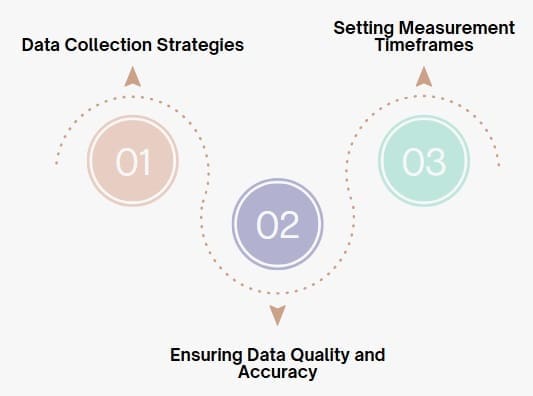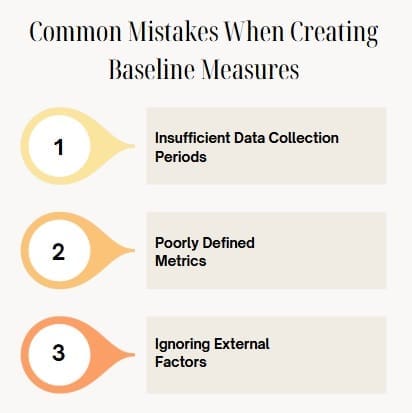When organizations embark on improvement initiatives, they often overlook a critical first step that determines success or failure. This fundamental component, known as a baseline measure, serves as the cornerstone for meaningful progress evaluation and strategic decision-making across industries.
Table of contents
What is a Baseline Measure?
A baseline measure represents the initial performance level or starting point before implementing any changes, interventions, or improvements. Think of it as taking a snapshot of your current situation to establish a reference point for future comparisons.
This measurement captures the existing state of affairs, providing concrete data that organizations use to track progress and measure success.
Furthermore, it eliminates guesswork by establishing clear, quantifiable starting points. They create accountability by documenting where you began, making it impossible to dispute progress or lack thereof. Additionally, these measures help organizations set realistic goals based on actual performance rather than assumptions.
Public, Onsite, Virtual, and Online Six Sigma Certification Training!
- We are accredited by the IASSC.
- Live Public Training at 52 Sites.
- Live Virtual Training.
- Onsite Training (at your organization).
- Interactive Online (self-paced) training,
Importance
Organizations that skip establishing proper baseline measures often find themselves unable to demonstrate improvement or justify investments. Without this foundation, you cannot accurately assess whether your initiatives deliver real value or merely create the illusion of progress.
Business Performance Enhancement
It drives business performance by providing clear direction for improvement efforts. When you understand your starting point, you can allocate resources more effectively and focus on areas with the greatest potential impact. This strategic approach leads to better return on investment and more sustainable improvements.
Moreover, baseline measures help identify performance gaps that might otherwise go unnoticed. They reveal hidden problems and opportunities, enabling proactive rather than reactive management approaches.
Data-Driven Decision Making
Organizations relying on baseline measures make more informed decisions because they ground their choices in factual data rather than opinions or assumptions. This evidence-based approach reduces risk and increases the likelihood of successful outcomes.
Subsequently, it supports continuous improvement by providing ongoing reference points for performance evaluation. They enable organizations to track trends, identify patterns, and adjust strategies based on actual results.
Types of Baseline Measures Across Industries

Different sectors utilize various baseline measures depending on their objectives and operational requirements. Understanding these variations helps organizations select the most appropriate measures for their specific needs.
Healthcare Baseline Measures
Healthcare organizations commonly use baseline measures to track patient outcomes, treatment effectiveness, and operational efficiency. These measures include patient satisfaction scores, readmission rates, infection rates, and treatment response times.
For instance, hospitals establish baseline infection rates before implementing new hygiene protocols. They then compare subsequent infection rates to the baseline to measure protocol effectiveness. Similarly, clinics track baseline patient wait times before process improvements and monitor changes thereafter.
Manufacturing Performance Baselines
Manufacturing companies rely heavily on baseline measures to optimize production processes and quality control. Common measures include defect rates, production cycle times, equipment downtime, and safety incidents.
Consider a manufacturing plant that establishes a baseline defect rate of 3.2% before implementing new quality control procedures. After six months, they measure a defect rate of 1.8%, demonstrating clear improvement from their baseline measure.
Marketing and Sales Baselines
Marketing departments establish baseline measures for campaign performance, lead generation, and customer acquisition costs. These measures provide foundations for evaluating marketing strategy effectiveness and resource allocation decisions.
Sales teams use baseline measures such as conversion rates, average deal size, and sales cycle length to track performance improvements and identify areas needing attention.
How to Establish Effective Baseline Measures?

Creating meaningful baseline measures requires careful planning and systematic execution. Organizations must follow proven methodologies to ensure their measures provide accurate and useful information.
Data Collection Strategies
Begin by identifying what you want to measure and why it matters to your organization. Select metrics that align with your strategic objectives and provide actionable insights. Avoid measuring everything; instead, focus on key performance indicators that drive meaningful outcomes.
Next, determine the appropriate time period for data collection. Some measures require daily tracking, while others need weekly, monthly, or quarterly assessment. The frequency should match the nature of what you’re measuring and how quickly changes occur.
Ensuring Data Quality and Accuracy
Reliable baseline measures depend on high-quality data collection processes. Establish clear data collection protocols, train personnel properly, and implement quality control checks to minimize errors and inconsistencies.
Additionally, document your measurement methodology thoroughly. This documentation ensures consistency over time and enables others to understand and replicate your approach. It also helps identify potential sources of variation that might affect your results.
Setting Measurement Timeframes
Choose measurement periods that capture normal operational variations while providing sufficient data for reliable baseline establishment. Avoid periods with unusual circumstances that might skew your baseline measures.
For example, retailers should avoid establishing baseline sales measures during holiday seasons or promotional periods that don’t represent typical performance levels.
Common Mistakes When Creating Baseline Measures

Organizations frequently make errors that compromise the effectiveness of their baseline measures. Recognizing these pitfalls helps ensure your measures provide valuable insights rather than misleading information.
Insufficient Data Collection Periods
One common mistake involves collecting baseline data for too short a period. This approach can result in measures that don’t accurately represent normal performance levels, leading to incorrect conclusions about improvement efforts.
To avoid this error, collect baseline data long enough to capture typical operational variations and cycles that affect performance.
Poorly Defined Metrics
Another frequent problem occurs when organizations fail to define their metrics clearly. Vague or ambiguous measures lead to inconsistent data collection and unreliable results that cannot support effective decision-making.
Therefore, create specific, measurable definitions for each baseline measure that leave no room for interpretation or confusion.
Ignoring External Factors
Organizations sometimes establish baseline measures without considering external factors that influence performance. These factors can include seasonal variations, market conditions, regulatory changes, or other environmental influences.
Consequently, baseline measures should account for these external factors to ensure meaningful comparisons over time.
Best Practices for Implementation
Successful implementation requires adherence to proven best practices that maximize their effectiveness and reliability.
Stakeholder Engagement
Involve relevant stakeholders in the baseline measure development process to ensure buy-in and support. When stakeholders understand and contribute to measure selection, they’re more likely to support improvement initiatives and provide accurate data.
Furthermore, stakeholder involvement helps identify potential challenges and opportunities that might otherwise be overlooked during the planning process.
Technology Integration
Leverage technology to automate data collection and analysis wherever possible. Automated systems reduce manual errors, improve consistency, and free up resources for more valuable activities.
Modern tools can capture baseline measures in real-time, providing more accurate and timely information for decision-making purposes.
Regular Review and Updates
These aren’t set-and-forget tools. Regular review ensures they remain relevant and continue providing valuable insights as organizations evolve and change.
Schedule periodic reviews to assess whether your baseline measures still align with organizational objectives and provide actionable information.
Measuring Success Against Your Baseline
Once you’ve established solid baseline measures, the real work begins. Organizations must systematically track performance against these measures to identify trends, celebrate successes, and address areas needing improvement.
Statistical Analysis Techniques
Apply appropriate statistical methods to analyze changes from baseline measures. Simple percentage changes may suffice for some measures, while others require more sophisticated analysis to account for variables and trends.
Consider using statistical process control charts to visualize performance relative to baseline measures and identify when changes represent genuine improvements rather than normal variation.
Reporting and Communication
Develop clear reporting mechanisms that communicate baseline measure results to relevant stakeholders. Effective reports highlight key findings, explain their significance, and recommend actions based on the data.
Visual representations such as charts and graphs often communicate baseline measure results more effectively than tables of numbers alone.
Advanced Applications
Organizations can extend its applications beyond basic performance tracking to support more sophisticated improvement initiatives and strategic planning efforts.
Benchmarking and Comparative Analysis
Use them as foundations for benchmarking against industry standards or competitor performance. This comparative approach provides context for your performance levels and identifies opportunities for improvement.
External benchmarking helps organizations understand whether their baseline measures represent competitive performance or indicate areas needing significant improvement.
Predictive Analytics Integration
Combine baseline measures with predictive analytics to forecast future performance trends and identify potential issues before they become problems. This proactive approach enables organizations to take corrective action early and maintain desired performance levels.
Machine learning algorithms can analyze patterns in baseline measure data to predict future outcomes and recommend optimization strategies.
Final Words
In Six Sigma, a baseline measure is the initial measurement of a process’s current performance. It serves as a critical starting point in the Define and Measure phases of the DMAIC (Define, Measure, Analyze, Improve, Control) methodology. This metric helps identify where the process stands before improvements are made.
Frequently Asked Questions About Baseline Measures
How long should I collect data before establishing a baseline measure?
The data collection period depends on your specific measure and operational cycles. Generally, collect data for at least one complete operational cycle (monthly, quarterly, or annually) to capture normal variations. For daily measures, 30-90 days often provides sufficient baseline data.
What should I do if my baseline measure shows poor performance?
Poor baseline performance actually provides valuable information by highlighting improvement opportunities. Use this data to prioritize improvement efforts and set realistic goals for enhancement. Remember, baseline measures simply reflect current reality and provide starting points for improvement.
Can I change my baseline measure after establishing it?
While consistency is important for tracking progress, you may need to adjust baseline measures if operational changes make them irrelevant. When changes are necessary, document the reasons clearly and establish new baseline measures using the same rigorous methodology.
How many baseline measures should my organization track?
Focus on a manageable number of measures that align with your strategic objectives. Most organizations effectively track 5-15 key baseline measures rather than attempting to measure everything. Quality and consistency matter more than quantity.
What tools can help me establish and track baseline measures?
Various tools support baseline measure development, from simple spreadsheets to sophisticated business intelligence platforms. Choose tools that match your technical capabilities and data complexity requirements. Many organizations start with basic tools and upgrade as their measurement maturity increases.



















